Travelling with Tribal Tracks is a wonderful experience. They take care of everything and you don't have to worry about anything!
Gordon GLocation
Difficulty
Accommodation and Meals
Hotel, Guesthouse, Village Homestay, Lodge
Duration
10 days
Meeting Point
Kota Kinabalu
Annual Leave
6 days
Group Size
Up to 14
Seasons
March to October
Walking Distance
Approximately 70km

Kate is an Army Officer and despite all that entails, works for Tribal Tracks in her spare time. She is a wonderful leader and one of our most popular.
Trek a historic route, learning from an expert about the brave, heroic and ultimately tragic Australian and British Prisoners of War, captured by the Japanese in World War II.
Pay homage to them, and to all who serve today, by digging deep to summit Mount Trusmadi, Borneo's second highest mountain, and arguably a tougher summit than Mount Kinabalu.
Learn about the wonderful jungle flora and fauna as you trek.
Understand local culture and sample delicious food while staying in traditional guesthouses and a Borneo longhouse.
All the info you need
Trip Details
Join the Faith in Families team on this truly unique adventure. This very special trek has two distinct phases. In the first part, we follow the echoes of the past, trekking in the footsteps of the brave, heroic and ultimately tragic Australian and British Prisoners of War, captured by the Japanese in World War II. We then pay homage to them, and to all who serve today, by digging deep to summit Mount Trusmadi.
**The price is £1795 based on a team of 10 people, there will be an additional £75 per person for a smaller group of 7 - 9 people, we will run the trip on a minimum of 7 people . Please note flights are not included in the price and these will need to be booked individually. We will provide details of recommended flights to Kota Kinabalu. You will need to arrive into Kota Kinabalu by mid afternoon on 7 September 2024. Flights are from £900 per person using Malaysian or Singapore Airlines.**
Phase 1 - The Death March Trek
Sandakan was a POW camp, located on Sabah’s north-east coast. Following the fall of Singapore, the Japanese transferred the 2700 strong Allied Contingent to this camp. Australian and British POWs were incarcerated there, tasked with constructing a military airfield using not much more than their bare hands. Initially, conditions were not too bad, but after the discovery of a radio, conditions were drastically tightened. Starved, and living in filthy conditions, in January 1945, the Japanese decided to move 455 of the fittest prisoners to Jessleton (now Kota Kinabalu) where they would be put to use as labourers. Forcing them to march through remote, inhospitable jungle terrain, the first group was halted at Ranau due to Allied air activity on the coast. A second enforced march took place at the end of May, with the third following on in mid-June. There was no medical assistance and little food. Anyone who could not keep up was ‘disposed of’. Despite this, about half the prisoners completed the march, only to die at Ranau from illness, malnutrition and ill-treatment by their captors. Two Australians managed to escape in the early stages of the second march with the help of villagers, and four more successfully escaped from Ranau into the jungle, where they were cared for by local people.
Despite this, the prisoners never gave up. Their heroism, their determination and their indomitable spirit are testimony to the strength of the human spirit and an inspiration to all. Of the 2434 prisoners incarcerated at Sandakan, 1787 were Australian. The remaining 641 were British. The six Australians who escaped were the sole survivors.
The track cut for the death marches soon became completely overgrown and for sixty years defied all efforts to locate it. However, in August 2005, Australian investigative writer and historian, Lynette Silver, author of the internationally acclaimed book Sandakan – A Conspiracy of Silence, and Tham Yau Kong, highly respected, expert jungle trekker, combined their considerable talents to identify the path taken by the prisoners of war.
On this trek, we will have the honour of being accompanied by Tham Yau Kong who will share the history of the marches as we go, giving us a unique insight. We cannot trek the full route, but our expert guides have selected the most appropriate sections for us, where they bring the history of the march to life. The trek is through tough jungle terrain, and involves some wading through shallow rivers, but gives us a inkling of what the POWs went through so many years before.
Phase 2 - Mount Trusmadi
Standing at 2642m, Mount Trusmadi is the second highest mountain in Malaysia and is located in the Trusmadi Forest reserve. The terrain is challenging and some argue a tougher climb than Mt Kinabalu, the highest mountain, but is a much more interesting mountain. house where the team will stay overnight. This is a physically demanding and steep summit trek, with the steeper sections having ladders and ropes.
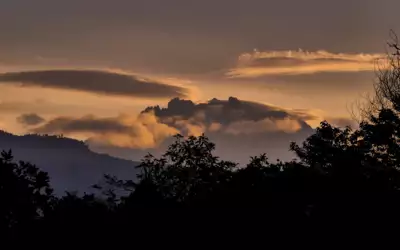
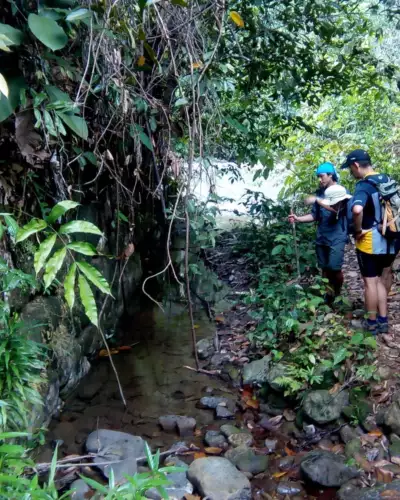
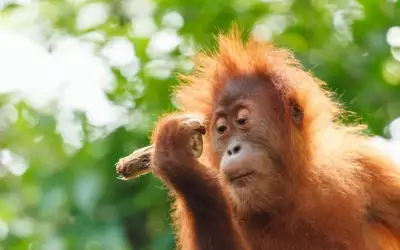
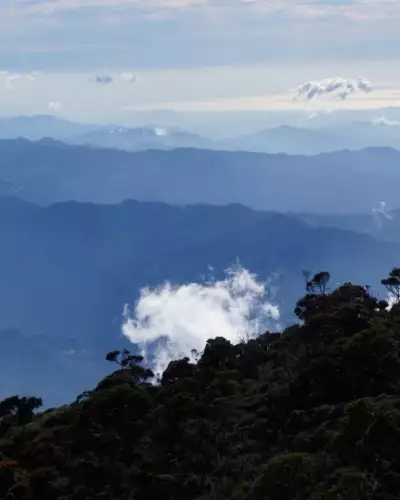
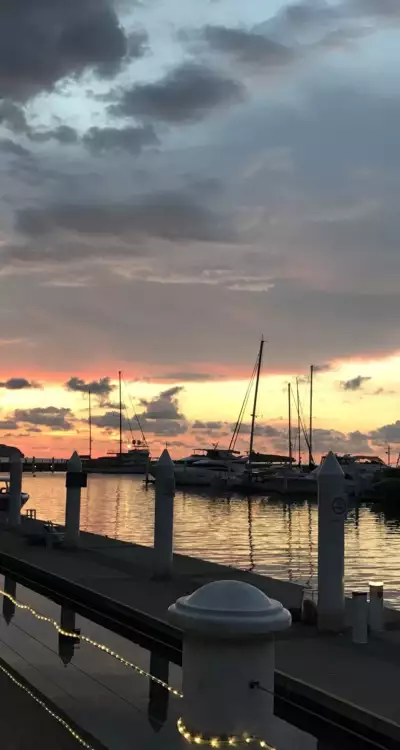
Trip Details
After an early breakfast, we depart Kota Kinabalu and head to Telupid, approximately 250km and 4 – 5 hours away. Lunch will be in Ranau, where the three marches concluded, before heading to the start of the first part of the trek.
The start of the trek is at base of Bauto Hill and the route travels through the Tawai Forest Reserve. Surrounded by secondary jungle terrain, we ascend to the top of Bauto Hill and then descend to Telupid. This 8km route follows the Death March and will take approximately 4 hours. At the end of the trek, it is a 15 minute transfer to our Resthouse in Telupid. Dinner is local cuisine, cooked by locals and brought to us.
Accommodation and Meals
Overnight local guesthouse, full board.
It is an early start with breakfast at 6am and ready to depart at 7am for a short transfer Gambaron.
The first part of the trek is under the primary jungle canopy which then opens up onto wider tracks. We will cross some small streams and then onto our river crossing at Telupid river, approx. 1 – 2 ft deep, if the river is fast flowing we will have the option of a bridge crossing. The route is 18km and will take about 7 - 8 hours. There will be a short transfer from the end of the trek back to our Resthouse, where there is the option of enjoying a swim in the river after the trek.
Accommodation and Meals
Overnight local guesthouse, full board.
The starting point for the trek is at Kopuron village and it is a short transfer to the village.
The team will meet the son of late Mr Zudin, well known in for his part in using his blowpipe during WW2 to kill many Japanese soldiers. His son will teach you how his father used the blowpipe. After saying farewell we continue the Death March route, passing through villages path and farmland. We walk upstream along a small river to the top of Taviu Hill. There will be vehicles waiting for you at the end of the trek to transfer you to Sabah Tea Plantation. At Sabah Tea Plantation you will stay in a traditional Longhouse.
Accommodation and Meals
Overnight traditional Longhouse, full board.
After breakfast we take a short transfer to Nabutan village to finish the final leg of the Death March route to Muruk village.
Passing through farmlands and orchard to reach Nalapak village for our lunch stop, we then begin our final (and emotional) trek to Muruk village. The route is approximately 18km.
Accommodation and Meals
Overnight traditional Longhouse, full board.
It is time to enjoy a relaxing day before the Mount Trusmadi Summit.
After breakfast we transfer to Poring Hotsprings. There will be an opportunity to walk the canopy walkway and swim in the pools. After lunch, it is time to head to Tambunan and prepare for our summit trek.
Accommodation and Meals
Overnight hotel, full board.
Our 4x4 vehicles will meet us after breakfast and take us to the start of the trek in the foothills of Mount Trusmadi.
The approach route is approximately 4km, and this is a gentle and easy walk along the boardwalk to Midway campsite. After dinner, we will have our briefing and pack our kit for the morning; we will need to get an early night so we are ready for the summit day!
Accommodation and Meals
Overnight wild camping, full board.
Departing at 0230hrs we start our ascent with our headtorches on.
The 3km route is physically demanding and there will be large vines and tree roots to climb over.
Departing before sunrise we start our ascent, there will be large vines and tree roots to climb over and there will be some scrambling . There are ladders and fixed ropes to help negotiate the steeper sections of the trek. Our aim is to reach the reach summit at sunrise so we can enjoy the 360 stunning views. We retrace our steps and descend to Midway cabin and onto Tambunan. We will meet our transport and head to Kota Kinabalu to enjoy our final night celebration.
Accommodation and Meals
Overnight hotel, full board including celebration dinner.
Trip Details

| From/To | Nights | Total Cost (includes non-refundable deposit) | Non-refundable Deposit |
Fundraising Commitment |
Places | Enquiry | |
|---|---|---|---|---|---|---|---|
|
Sep 06, 2024 Sep 15, 2024 |
9 | £1795 | £400 | Places Available |
Trip Details
This is what you will need to buy/source yourself.
It is important that you read the itinerary carefully, and take account of the rating we have given it.
Although our challenges are not technical, they do require a good degree of physical fitness. The conditions will require stamina and strength, which you should recognise and train for. This will be a much better experience if you are fit and prepared. You should feel comfortable walking 6-8 hours per day.
In setting the maximum size of our groups, we take a number of factors into account.
Altitude, degree of difficulty, the terrain, the climate and time of year, all determine the maximum group size. Sometimes it will be 20, sometimes it will be 8-14, but safety is always our priority.
The minimum number to participate is 2. You will be accompanied by a Tribal Tracks UK Leader, Mountain Leader qualified, as well as supported by our local, in-country guides.
It is a requirement of Tribal Tracks booking terms and conditions that each supporter must hold their own travel insurance which covers the trip and the activities they are doing.
We advise you to put insurance in place as soon as possible. Your insurance must be valid and in date, covering the entire period that you are travelling for, including the return journey home. It should cover medical and personal accident risks, and should include repatriation costs and air ambulance or helicopter rescue services, where appropriate. We are happy to help you if you have any queries about this or have any difficulties.
Tribal Tracks has 100% Financial Protection and has a trust account with the Protected Trust Service, member number 5566.
This means that all client monies paid to Tribal Tracks are held in our dedicated trust account, which is supervised by an independent trustee. This means that in the very unlikely event that Tribal Tracks ceases to trade, your money is safe. For more information, please visit this link. Any flights booked for you by Tribal Tracks will be ATOL protected under our own ATOL certificate.
Tribal Tracks considers the safety of all of its participants and staff to be a top priority, and as such we have thorough safety systems in place.
In the event of an injury, we have an evacuation plan in place for all elements of the trek route. We do ask that you look after yourself during the trek in the following way, as this will help avoid unnecessary problems:
We know that the unexpected can happen.
While you are away, things can happen at home and people may need to get in contact with you. This can be tricky when you are in remote areas. So, shortly before departure, we provide you with an Emergency Procedure document to distribute to your nearest and dearest. This sets out how to contact Tribal Tracks and the steps Tribal Tracks will then take to get in contact with you.
It is really important that you are well prepared for your physical challenge and that you are confident that you will be able to fully participate.
Although our leaders are well trained to deal with different capabilities, if they have any concerns about someone’s ability to safely partake in the trek, or their impact on other people’s enjoyment, we authorise them to take necessary action which, in some circumstances, may involve asking someone to step out of the trek. Although this is a very rare occurrence, by booking this trip you agree to section 11 of our Booking Conditions which clearly states that our leaders have the authority to do this. In these circumstances, we will ensure anyone sitting out is safely provided for and offered alternative options where possible. Refunds will not be provided for activities missed and customers may be liable for additional costs incurred.
At Tribal Tracks, Responsible Travel is enormously important to us, and our commitment to responsible travel is evidenced in every itinerary that we prepare.
Core to our business is the belief that holidays can and should be enjoyable to the traveller but should be conducted in a socially, environmentally and economically responsible manner which brings benefit to local communities. This is implemented through a variety of measures which can be found in our Responsible Travel policy - http://www.tribaltracks.co.uk/responsible-travel-policy. We encourage you to read this and to play your own part in travelling responsibly.
Trip Details
Trip Details
The trek is a challenge. We will be walking for a long time over sometimes challenging terrain with steep ascents and descents.
The best way to build endurance fitness is to start with some gentle walks and gradually build up both the distance and duration over the next few months. In the last 2 months, we would recommend to go out and do long days, ideally in the hills, to build up the strength in your legs. About a week before the trek, limit any training to short walks – you want to have fresh legs at the start!
For the trek you should be comfortable trekking between 6 - 8 hours per day, but remember we have all day to achieve the distances and will not be going at racing snake pace. It may sound obvious, but make sure that you are walking properly, hitting the ground with your heel first, then rolling onto your toe, which pushes you onto the next step (this will help reduce the risk of shin splints and tendon pulls). Walk with your head up, eyes forward and shoulders level.
It is a good idea to develop a level of cardiovascular fitness (exercising and strengthening your heart and lungs). This comes from running, cycling or swimming for between 20 minutes and an hour, and will really help develop your endurance fitness. Three sessions a week is normally advised, increasing time and distance over time.
Replicate conditions in training i.e., use all the kit you will be using and try your walking poles if you want to use them.
It is important to pack so that you know where everything is. Separating kit into different packing cubes, or even plastic bags can really help with this. You can pack by item (eg socks and pants in one cube, tops in another etc) or by day, putting your entire outfit for that day together in one place. Taking an extra bag or cube to separate dirty kit is a great idea.
You will have two bags on the trip - your main bag and your back pack.
You should operate on the basis that you will not have access to your main bag during the day and while you are trekking. This means that it is important to have everything you need in your back pack. Waterproofs should go in the bottom, together with an extra layer, sunscreen and sunglasses, plus hat and gloves (if you are in a colder climate). You should also have your water bottles, and any specific snacks, medicines or first aid items you want to take, such as zinc tape and blister plasters. Baby wipes/toilet roll and nappy sacks are also essential for going to the toilet while you are trekking - we will explain more in the pre-departure briefing!
In the event of an injury, we have an evacuation plan in place for all elements of the trek route. We do ask that you look after yourself during the trek in the following way, as this will help avoid unnecessary problems:
We will brief you in the pre-departure briefing as to the catering specifically for your trip. However, as a guide, each morning you will be provided with a very filling local breakfast, usually accompanied by tea or coffee. Lunch will be during your trek and will be prepared by the team of cooks or we will utilise local restaurants or teahouses. Food will always be ample and tasty. If wild camping, dinner will be in the dining tent and will be traditional, freshly prepared food. If you are staying in a hotel or teahouse, dinner will be served there. Water, tea and coffee will be served and alcohol will usually not be available, although there will be some exceptions. We will provide 4 litres of drinking water per person per day. You will need to fill up 2 litres at breakfast and another 2 litres at lunchtime.
Please ensure that you have notified us before departure if you have any specific dietary requirements or allergies as we can cater for most.
Please inform us of any dietary requirements or allergies before you travel, and preferably at the time of booking. We can cater for almost all diets, so please just let us know. We can't cater for you if we don't know what you need!
You will sleep in shared tents (unless a single supplement has been requested). Mattresses are provided, which makes it much more comfortable! There will be a central dining tent available with rugs and lights where the group can get together in the evening, share stories and enjoy meals. There will also be an open fire wherever it is possible.
Sleeping bags are designed to work by trapping your body heat in the down surrounding you. If you wear lots of layers, your body heat will not be able to escape as effectively, and you will be cold. Wearing a thin thermal layer is ideal. It does sound counter intuitive, but we promise that it works!
Putting your clothes for the next day in the bottom of your sleeping bag will also help with warmth, as it will fill up any spare space around your feet, and it will mean your clothes are nicely warmed up in the morning.
If you find it difficult to sleep without a pillow, we recommend that you take a travel pillow and a regular pillowcase with you. Put your pillow in the pillow case, and use your down jacket/layers to fill out the pillowcase, you will end up with a pretty decent pillow!
And as for stuff or roll when it comes to packing your bag away? We are very much in the stuff camp!
There will be early morning starts, typically around 0600 - 0700hrs, so that the team can set off on the trek in good time. It is important that you pack up your kit before breakfast and leave your bag outside your tent or accommodation so that the crew can load them onto the jeeps and/or mules. There will be a freshly cooked lunch provided on your trek route. The aim is to get into camp before sunset if possible, when you can enjoy a hot drink and snacks. It is important that you change into your thermals and put layers on when you get into camp as the temperatures can drop sharply and you need to keep warm.
In the morning, the Tribal Tracks leader will wake up the group. When you hear the call, please begin to get ready, and pack all your kit away in your 'main bag' before breakfast. Put this bag outside your tent or accommodation as the crew can then begin to break down the tents/load the luggage. Ensure that you have all that you need in your backpack for the day, as you will not have access to your main bag until the next camp (see 'What do I put in my backpack?).
When you arrive into camp, it is important to get changed into different clothes, usually the ones that you will be wearing the next day. Even if you have had dry weather, you will have been sweating, and your clothes will be damp. As the sun sets and the air cools, you will quickly feel cold. Before this, you will want to freshen up and we recommend the 'baby wipe bath'. As there are no showers while on the trek, having a freshen up with a baby wipe will help keep you clean and will make you feel much better, before you put your clean clothes on. Unpack your sleeping bag and get everything out that you need for nighttime, such as your warm hat, jacket, head torch and book. Sort out your back pack for the next day by removing rubbish and replenishing snacks etc.
Doing this before dinner will mean you can get into your sleeping bag quickly, when it is likely to feel cold.
There will be a toilet tent and water supplied for washing in the morning where we can. There are no shower facilities provided during the trek and there will be no toilets either, but there will be a toilet tent in camp in the evenings and mornings. In the pre-departure briefing, we will tell you all that you need to know about how to deal with this.
For up-to-date vaccinations information please visit the NHS website ‘Fit for Travel’ at: http://www.fitfortravel.nhs.uk. The Tribal Tracks team are travel professionals, but we are not medical experts, and we would encourage you to visit your GP or travel nurse to discuss vaccination requirements. Please remember to take your itinerary with you so that they can see where you will be travelling. You should make an appointment at least 3-4 months before you travel.
In addition, please note that information on vaccinations can change at short notice; we recommend that you contact your Medical Professional or a Travel Health Clinic at least 8 weeks prior to departure for the most up to date information.
We recommend that you bring a multi-region adapter plug with you. There will be no facility to recharge electrical items on the trek, so we recommend you bring a power bank to top up the charge. We also recommend putting your phone on Airplane mode during the day to save on power.
Using your mobile overseas can sometimes attract unwelcome, very high tariffs. We recommend that you check with your network provider before you travel, but if in doubt, keep your phone switched to Airplane mode and use it only when there is WiFi. Reception can also be patchy, and unreliable, particularly in remote areas, which is why we carry a satellite phone with us. Please let your nearest and dearest know about this, and warn them that you may not be able to be in regular contact.
We ask that your luggage is kept to the absolute minimum. We will tell you the weights that you should not exceed, but usually, your main bag should not exceed 23kgs in weight.
It is important that you wear, or take your trekking boots with you in your hand luggage on the flight, as they are vital for the trek and cannot be replaced in the event of lost luggage.
We recommend leaving behind items such as high value jewellery, watches etc. Your passport and money should be always kept on you.
Trip Details
Borneo is a wonderful place to explore and there are amazing animal sanctuaries where you can view some of the wildlife unique to this huge island. If you want to explore further, please contact us for a bespoke extension package.
Let’s get you on the right track!